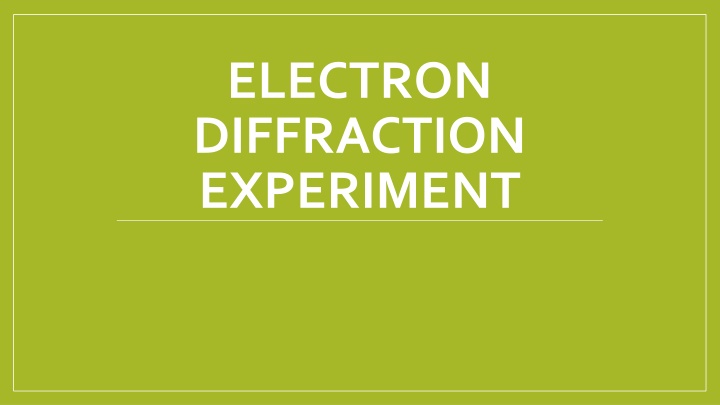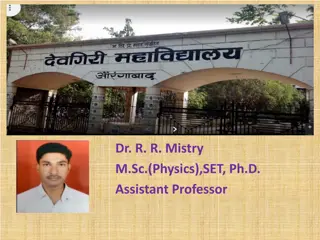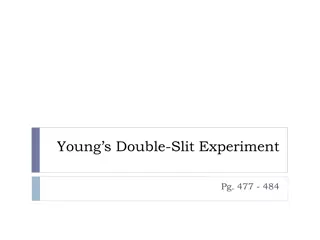Exploring Wave-Particle Duality in Electron Diffraction Experiment
Delve into the fascinating world of wave-particle duality through an electron diffraction experiment that reveals the dual nature of particles and waves. By investigating the wave characteristics of electrons and measuring their De Broglie wavelength, this experiment sheds light on the fundamental principles of quantum physics. Discover the interplay between waves and particles in a captivating scientific exploration.
Download Presentation

Please find below an Image/Link to download the presentation.
The content on the website is provided AS IS for your information and personal use only. It may not be sold, licensed, or shared on other websites without obtaining consent from the author.If you encounter any issues during the download, it is possible that the publisher has removed the file from their server.
You are allowed to download the files provided on this website for personal or commercial use, subject to the condition that they are used lawfully. All files are the property of their respective owners.
The content on the website is provided AS IS for your information and personal use only. It may not be sold, licensed, or shared on other websites without obtaining consent from the author.
E N D
Presentation Transcript
ELECTRON DIFFRACTION EXPERIMENT
Wave-Particle Duality Up until now, when you have met waves and particles, you will have treated them as separate entities. However, you will soon find that particles exhibit wave like behaviour and vice versa! This experiment will illustrate this. o Example: Light. Behaves like waves in Young s double slit, behaves like particles in the photoelectric effect. In 1926, De Broglie brought forward his theory on wave-particle duality, which predicted the above phenomena Today you will perform a very similar experiment, in which you will investigate the wave nature of electrons, measuring there De Broglie wavelength. You will also use them to measure the lattice spacing of graphite.
In The Box In the box you will find: A cathode ray tube (electron gun) containing a piece of graphite that acts as a diffraction grating A high voltage power source Vernier Callipers Power pack
Set up Set up the apparatus as shown below. Make sure the wiring behind the electron gun matches that on the image!
What is happening? Electrons are produced with an electron gun, a cathode filament which produces electrons when heated by a small lamp in the apparatus. The electrons are accelerated across a large potential difference They pass through a thin layer of graphite which acts as a diffraction grating A diffraction pattern of two circular rings will appear on the screen. Check you can see this. The lights may need to be turned off. The radius of the rings should change with changing voltage, verify this also occurs.
Procedure Connect up the apparatus and play around with the voltage until you see two well defined rings. Pick a voltage and measure the diameter of both rings using the Vernier Callipers Question: What will you use as your uncertainty in the diameter measurement? Answer: The largest source of uncertainty should arise from the thickness of the rings, which should be a few mm. Now you can determine the de Broglie wavelength. Using one of your diameter measurements, determine the electron momentum. Question: Staring from the electron gun equation, how can you obtain electron momentum?
Answer The electron gun equation: ?? =1 2??2 Multiply this by the mass: ??? =1 2?2?2 Since momentum p=mv ??? =1 2?2 Rearrange for p ? = 2???
Now we can calculate the de Broglie wavelength using: = ? Where h is the Planck s constant and p is the electron momentum
Graphite Spacing Now we can calculating the lattice spacing of the atoms in the graphite film. Question: Why is it that the graphite can be used to diffract the electrons? Answer: The de Broglie wavelength is of a similar order of magnitude as the graphite spacing. The de Borglie wavelength is located to the graphite spacing d by: =?? ? Where r is the radius of the ring in question and L = 135mm is the distance between the sample and the screen
Result Calculate both the lattice spacing's (one for each ring) Question: Why are there two difference lattice spacing's? Answer: This piece of graphite follows a hexagonal structure, so one of the constants represents the space between atoms of the same layer, the other represents the spacing of adjacent atoms between layers. The accepted values are: 2.4612x10^-10 m 6.7079x10^-10m
Analysis Do your results for the spacing's agree with the accepted values within experimental uncertainty? If not, what went wrong? What was the largest source of error? Could the experiment be improved in any way?























